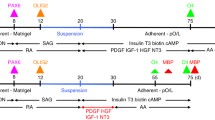Abstract
Although it is known that most cells of the vertebrate central nervous system (CNS) are derived from the neuroepithelial cells of the neural tube (reviewed in ref. 1), the factors determining whether an individual neuroepithelial cell develops into a particular type of neurone or glial cell remain unknown. A promising model for studying this problem is the bipotential glial progenitor cell in the developing rat optic nerve; this cell differentiates into a particular type of astrocyte (a type-2 astrocyte2) if cultured in 10% fetal calf serum (FCS) and into an oligodendrocyte if cultured in serum-free medium3. As the oligodendrocyte–type-2 astrocyte (0-2A) progenitor cell can differentiate along either glial pathway in neurone-free cultures2,4, living axons clearly are not required for its differentiation, at least in vitro. However, the studies on 0-2A progenitor cells were carried out in bulk cultures of optic nerve, and so it was possible that other cell–cell interactions were required for differentiation in culture. We show here that 0-2A progenitor cells can differentiate into type-2 astrocytes or oligodendrocytes when grown as isolated cells in microculture, indicating that differentiation along either glial pathway in vitro does not require signals from other CNS cells, apart from the signals provided by components of the culture medium. We also show that single 0-2A progenitor cells can differentiate along either pathway without dividing, supporting our previous studies using 3H-thymidine3 and suggesting that DNA replication is not required for these cells to choose between the two differentiation programmes.
Similar content being viewed by others
References
Jacobson, M. Developmental Neurobiology 2nd edn, 27–55 (Plenum, New York, 1978).
Raff, M. C., Abney, E. A., Cohen, J., Lindsay, R. & Noble, M. J. Neurosci. 3, 1289–1300 (1983).
Raff, M. C., Miller, R. H. & Noble, M. Nature 303, 390–396 (1983).
Abney, E., Williams, B. & Raff, M. C. Devl Biol. 100, 166–171 (1983).
Raff, M. C. et al. Nature 274, 813–816 (1978).
Bignami, A., Eng, L. F., Dahl, D. & Uyeda, C. T. Brain Res. 43, 429–435 (1972).
Raff, M. C. et al. Brain Res. 174, 283–308 (1979).
Eisenbarth, G. S., Walsh, F. S. & Nirenberg, M. Proc. natn. Acad. Sci. U.S.A. 76, 4913–4917 (1979).
Raff, M. C., Williams, B. & Miller, R. H. EMBO J. 3, 1857–1864 (1984).
Ranscht, B., Clapshaw, P. A., Price, J., Noble, M. & Seifert, W. Proc. natn. Acad. Sci. U.S.A. 79, 2709–2713 (1982).
Pruss, R. Nature 280, 688–690 (1979).
Bottenstein, J. E. & Sato, G. H. Proc. natn. Acad. Sci. U.S.A. 76, 514–517 (1979).
Holtzer, H. et al. Q. Rev. Biophys. 8, 523–557 (1975).
Johnson, G. D. et al. J. immun. Meth. 55, 231–242 (1982).
Author information
Authors and Affiliations
Rights and permissions
About this article
Cite this article
Temple, S., Raff, M. Differentiation of a bipotential glial progenitor cell in single cell microculture. Nature 313, 223–225 (1985). https://doi.org/10.1038/313223a0
Received:
Accepted:
Issue Date:
DOI: https://doi.org/10.1038/313223a0
- Springer Nature Limited
This article is cited by
-
Constitutional mislocalization of Pten drives precocious maturation in oligodendrocytes and aberrant myelination in model of autism spectrum disorder
Translational Psychiatry (2019)
-
The Role of eNSCs in Neurodegenerative Disease
Molecular Neurobiology (2012)
-
Post-Translational Modifications of Nucleosomal Histones in Oligodendrocyte Lineage Cells in Development and Disease
Journal of Molecular Neuroscience (2008)





